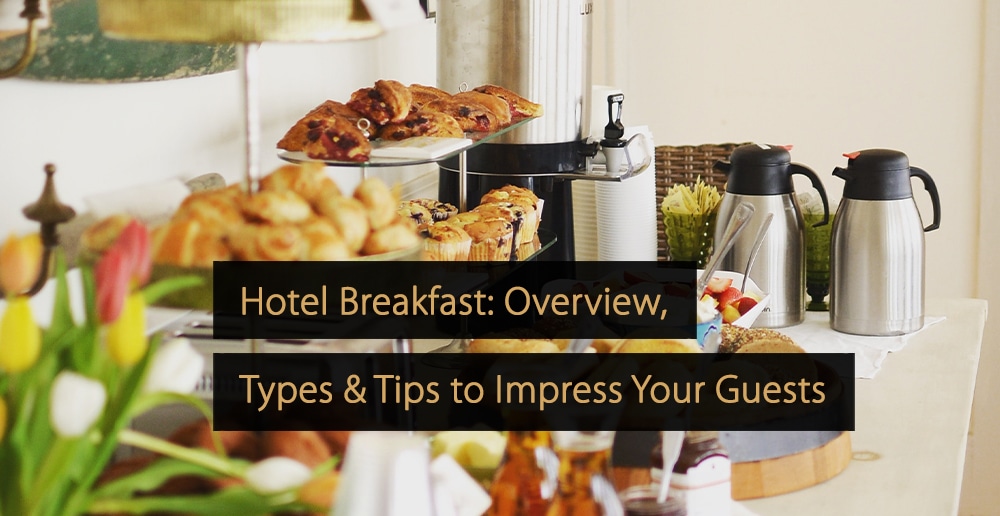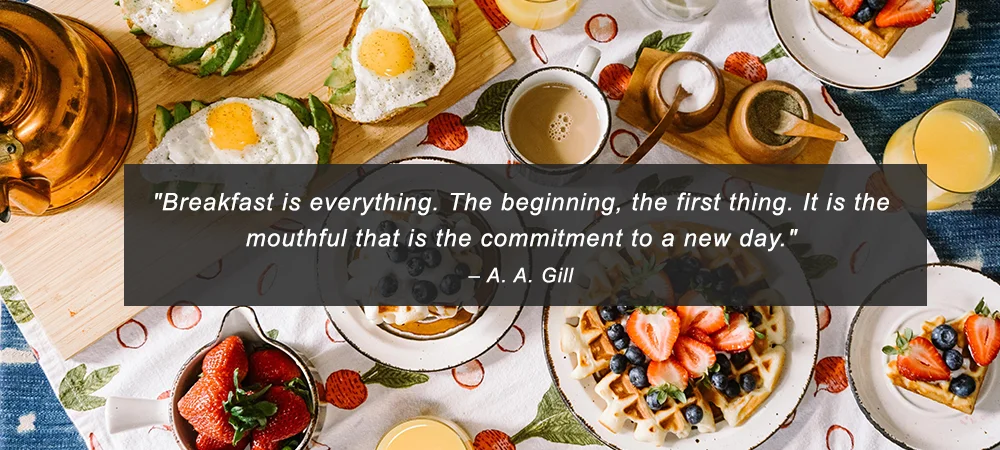Hotel breakfasts are a great way for guests to start the day and help your hotel stand out from the crowd. A delicious breakfast with varied options can create a good impression that will stay with your visitors. This article gives you an overview of hotel breakfast possibilities and how to exceed your guests’ expectations.
Table of Contents:
- What Is the Hotel Industry?
- Why Is a Hotel Breakfast Important?
- What Are Different Types of Hotel Breakfast?
- Ways to Serve Hotel Breakfast
- 6 Tips to Make Sure Your Hotel Breakfast Buffet Exceeds Your Guest’s Expectations
- Point-of-Sale Software as a Helpful Tool During Hotel Breakfast
- Hotel Departments and Different Sections of a Hotel
- Front Office Technology to Improve Hotel Breakfast
What Is the Hotel Industry?
According to the Hotels – Worldwide Report by Statista, the projected market volume by 2028 is $508.9 billion. The hotel industry is a vital component of the service industry. It’s part of the sector that exists to serve the needs of customers seeking accommodation overnight, distinct from other services such as food and beverages. The hotel industry is very closely tied to the hospitality industry, and also the travel industry; however, the scope of the hospitality industry is rather different to either of these.
In the most general sense, while the hotel industry provides certain hospitality services (dining, conference support, hotel breakfast, etc.), its primary focus is on providing comfortable and enjoyable spaces for rest overnight. These services can vary based on a hotel’s customer, from shared dorms favored by backpackers to luxurious suites for high-end travelers. To read more about the hotel industry and its differences from the hospitality sector, read the in-depth article “Hotel Industry: Everything You Need to Know About Hotels!”
Why Is a Hotel Breakfast Important?
A good hotel breakfast can be an important part of the overall experience. Whether your hotel is large or small, and whatever amenities you offer, a hotel breakfast can make the difference between a pleasant and exceptional stay. If a hotel breakfast is included in the room’s price, it’s important to provide an enjoyable breakfast so that guests feel they have received value for money. Even if the options are basic, good-quality food and drink will get a guest’s day off to a good start. Hotel breakfast is an opportunity to recharge and prepare for the day.
What Are Different Types of Hotel Breakfast?
There are many kinds of hotel breakfasts, from a simple self-service buffet consisting of a few basic items to more lavish fare.
Continental Breakfast
Despite its name, which implies a European origin, the UK hotel industry adopted the concept of a continental hotel breakfast. A continental breakfast is a lighter, simpler option than heavier meals like a full English breakfast. A continental breakfast usually consists of baked goods like croissants and bread rolls, served with various accompaniments like butter, jellies, jams, marmalade, etc. The archetypal continental breakfast includes a cup of freshly brewed coffee, but other drinks will also be offered. Some hotels also offer savory options, like cheese or cold meat, fruit, yogurt, and cereal.
English Breakfast
A full English breakfast is a large and hearty meal. It usually includes bacon, sausages, black pudding, fried tomatoes, mushrooms, eggs (scrambled or fried), and toast or fried bread. Tea is the usual accompaniment. This big, protein-rich meal is perfect for a guest planning a big day as it is very sustaining. Some guests eat a full English breakfast late in the morning so they don’t need to stop for lunch. All elements are hot foods and will be prepared freshly. A hungry guest might choose a large portion, but offering smaller portions for those struggling with full-sized English is a good idea.
American Breakfast
An American hotel breakfast includes elements of both the above types of breakfast. It will typically include bacon, eggs (fried), hash browns, pancakes or waffles with butter or syrup, toast with butter or jam/jellies, and coffee. It can be served buffet-style but is often prepared to order. Many hotels will make the pancakes from scratch so that the butter will melt when added by the guest. Although this option isn’t as heavy as full English, it’s still hearty and sustaining. An American breakfast isn’t a light option, although small portions are generally offered.
Table: Other Types of Hotel Breakfast
Ways to Serve Hotel Breakfast
There are various ways that hotels can serve breakfast to their guests. Some guests prefer to have breakfast served to them, while others like the experience of selecting items from a buffet.
Breakfast Buffet
A breakfast buffet consists of a long table or counter where guests can serve themselves various items. A typical buffet will include items like muffins, croissants, toast, and other baked goods; hot items such as sausages, bacon, fried potatoes or hash browns, scrambled eggs, etc.; fruit, yogurt, and cereals. A buffet-style breakfast allows guests to choose their favorite items and to eat as much as they like. Maintaining high standards of cleanliness and hygiene is important, as a buffet can become busy, and there’s a risk of contamination. Good presentation is vital for a pleasant buffet dining experience.
A la Carte
With an a la carte breakfast, guests will order individual items from a selection. A menu-style breakfast avoids many drawbacks of buffet-style hotel breakfasts, such as food waste and a chaotic atmosphere (hard to avoid when numerous guests are serving themselves). An a la carte breakfast typically doesn’t have as many options as a buffet. Still, everything is freshly prepared, and it’s possible to control the quality of each element more closely. A la carte breakfasts are a good option for smaller hotels, allowing more efficient handling of products and better direction for the workforce.
Room Service
A room-service hotel breakfast adds a touch of luxury to a guest’s stay. Instead of elbowing through the crowd around a buffet or eating in a packed restaurant, guests can enjoy a quiet breakfast in the comfort of their rooms. There are various ways that hotels can handle room service breakfasts. It can be delivered on washable plates or in disposable containers. You can customize breakfast services depending on your specific needs. Popular options include a breakfast card, from which guests can select items; a menu form the guest will fill out the night before; or breakfast boxes. Hotel technology, such as the hotel app, is another way for guests to order breakfast.
Video Example: Hotel Breakfast Room Service at Le Meurice
6 Tips to Make Sure Your Hotel Breakfast Buffet Exceeds Your Guest’s Expectations
While a breakfast buffet has many advantages, it can quickly become chaotic and messy without a proper strategy. Here are some tips to ensure your hotel’s breakfast buffet offers a smooth and enjoyable experience that impresses your guests.
1. Keep to Food Safety Regulations
Because your buffet will have dozens of guests visiting it, some multiple times, it’s important to have an up-to-date and detailed schedule for cleaning. Create a list of equipment to be used, a procedure for cleaning and replacing items before the buffet opens and while it’s in use, and a procedure for cleaning after it closes. Food, especially sensitive items like eggs, should be protected from air and sun. Don’t use plastic film — instead, have lids or plastic domes over serving dishes. For instance, surfaces should be frequently wiped down, and any utensils falling on the floor should be replaced immediately.
2. Make Sure The Buffet Is Aesthetically Pleasing
It goes without saying that foods should be of good quality and well-prepared. Presentation is also important, however. Everything on the buffet should look as good as it tastes. The containers, utensils, and materials you use should be chosen carefully to be both practical and in keeping with your desired aesthetic. The layout should be planned to maximize convenience and visual appeal. Staging your buffet in an appealing and inviting way will add a lot to your guests’ overall experience. It’s a great opportunity to enhance your guests’ perception of the service they receive.
3. Serve Certain Foods in Bulk and Others Individually
Buffets typically have some foods offered in bulk, such as a large dish of scrambled eggs from which guests can help themselves or cereal presented in a dispenser. Other foods, though, are better served in individual portions. One example might be butter. Certainly, you could place a block of butter on your buffet and let guests take what they need, but this will quickly look unsightly. It would also result in a lot of food waste, as any remaining butter would need to be thrown away after the buffet in case of contamination. Consider this when staging your buffet.
4. Provide Long-Lasting Labels for Efficiency and Communication
Clear labeling helps your guests see what foods are on offer. A guest who mistakes one food for another or finds out that a prepared food contains an undesirable ingredient, may be confused and disappointed. Durable and legible labels should be provided instead of staff explaining to guests what each dish contains. Card format labels in wipe-clean plastic are a good solution here. They can be placed in plastic or stainless steel holders and reused daily. This also avoids having staff make up new labels daily, saving time.
5. Create a Breakfast Ambiance
Because your guests may be eating breakfast in the same space where lunch and dinner are also served, you’ll want to create a different ambiance at breakfast time. A fresh, lively feel will help your guests enjoy the start of their day and provide a better experience. Choose music that is right for the atmosphere you want to set, and pay attention to your presentation. For example, you could use different tablecloths for the morning, selecting cheerful colors to put your guests in a more enthusiastic frame of mind.
6. Go A Step Further and Introduce a Regional Breakfast Offering
Enjoying the local cuisine is an unmissable part of any travel experience. Even if guests are traveling for business rather than pleasure, they’ll appreciate the opportunity to enjoy regional cuisine. Consider incorporating local foods into your hotel breakfast buffet and showcasing them. As well as providing a sense of quality, this will also demonstrate to your guests that you value both their experience and supporting the community. You can still offer standard buffet fare, but add a few local recipes to make your buffet stand out.
Point-of-Sale Software as a Helpful Tool During Hotel Breakfast
According to the Point-of-Sale Software Market Report by Precedence Research, the global point-of-sale software market is projected to reach $29.9 billion by 2032. There are many software solutions available to hotels today. POS software is one of the most important. Whether your guests settle their accounts or pay for a hotel breakfast, POS technology can make it easy and fast. POS software can automate many transactions and help generate additional revenue.
It can provide useful tools to make your staff’s lives easier. In “Benefits of Point of Sale Software for Hotels”, you’ll find out what point of sale software is and how it can help your hotel.
Hotel Departments and Different Sections of a Hotel
Hotels and resorts are made up of several different departments. There are departments such as the front office, which is the first point of contact for the public, but other departments are also vital for the successful operation of a hotel business.
In “Hotel Departments: Learn About All the 7 Sections of a Hotel”, you’ll find out about the different sections that make up a hotel. This article details the departments that make up a hotel, from the finance department to the food and beverage department that provides a hotel breakfast or a cocktail in the evening.
Front Office Technology to Improve Hotel Breakfast
Your front office department is key to creating a great impression on your guests. Technology can help you to do just that. Technology for the front office department has improved in leaps and bounds in recent years, and it’s important to keep up with the latest hotel trends in technology.
From checking in and out, handling service requests, or arranging a hotel breakfast, front-office technology helps guests interact more effectively with the front desk and facilitates daily tasks. In “Front Office Technology: The Latest Tech for the Reception Department”, you’ll discover all the possibilities these new solutions offer.
Hotel Breakfast FAQs
Breakfast is often referred to as the most important meal of the day, which can certainly be the case for the hotel industry. Hopefully, this article will have given you some ideas to make hotel breakfasts a highlight of your guests’ stay.
Did You Like This Article About Hotel Breakfast?
You might also be interested in the following articles:
- Hotel Maintenance Tips to Optimize & Increase Profitability
- Hotel Restaurant Management: Tips to Maximize Revenue for Your Hotel
- Hotel Packages: Tips to Optimize the Use of Hotel Package Deals
- Ways to Improve Customer Experience in the Hospitality Industry
More Tips to Grow Your Business
Revfine.com is the leading knowledge platform for the hospitality and travel industry. Professionals use our insights, strategies, and actionable tips to get inspired, optimize revenue, innovate processes, and improve customer experience.Explore expert advice on management, marketing, revenue management, operations, software, and technology in our dedicated Hotel, Hospitality, and Travel & Tourism categories.
This article is written by:
Hi, I am Martijn Barten, founder of Revfine.com. With 20 years of experience in the hospitality industry, I specialize in optimizing revenue by combining revenue management with marketing strategies. I have successfully developed, implemented, and managed revenue management and marketing strategies for individual properties and multi-property portfolios.











Thank you for this information. Respect for your work. Well done!